Antontsev S.N., Kazhikhov A.V., Monakhov V.N. Boundary Value Problems in Mechanics of Nonhomogeneous Fluids
Подождите немного. Документ загружается.

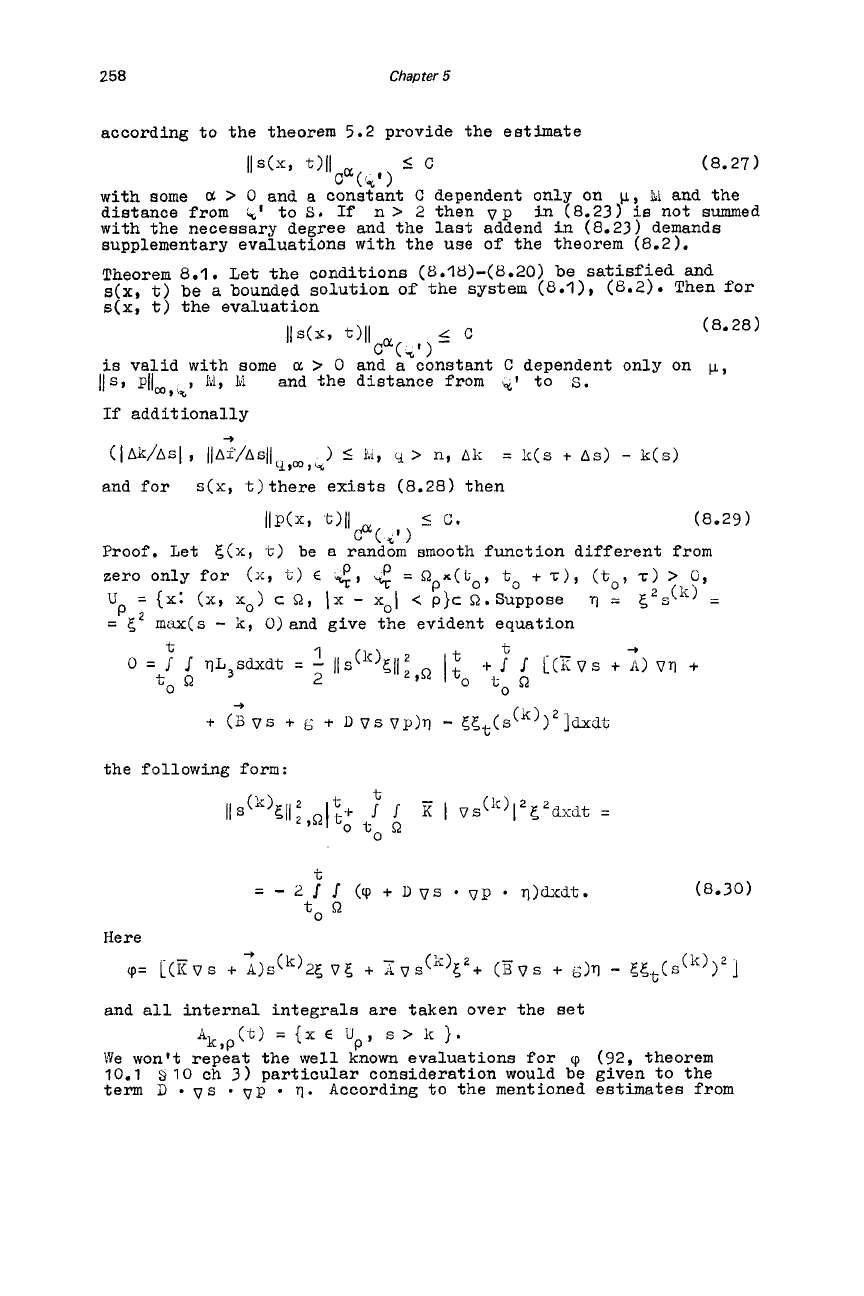
258
Chapter
5
according to the theorem 5.2 provide the estimate
IIs(x,
till
<c
(8.27)
with some
U
>
0
and
a
constant
C
dependent only on
p,
bi
and the
distance from
t'
to
S.
If
n>
2
then
vp
in
(8.23)
is
not summed
with the necessary degree and the
last
addend in (8.23) demands
supplementary evaluations with the use of the theorem (8.2).
Theorem
8.1.
Let the conditions
(8.18)-(8.20)
be satisfied
and
s(x,
t) be
a
bounded solution
of
the system
(8.1), (8.2).
Then for
S(X.
t)
the evaluation
Ca(kl>
is
valid with some
CL
>.
0
and a constant
C
dependent only on
p,
/IS,
P(I,,,%,
Ll,
BI
and the distance from to
s.
If
additionally
--t
(lAir/asl
9
I(Af/AS((
oo
%)
5
1.1,
q
>
n,
Ak
=
k(s
+
As)
-
k(s)
'I,
2
and for
s(x,
t)there exists (8.28) then
5
c.
(8.29)
Proof. Let
5(x,
5)
be
a
random smooth function different from
zero only for
(x,
L)
E
4,
4
=
~~x(t,,
to
+
t),
(to,
t)
>
O,
u
=
5'
max(S
-
k,
0)
and give the evident equation
=
{x:
(x,
xo)
c
Q,
\x
-
xol
<
p>c
uppos pose
-q
=
gzs("'
=
P
the following form:
and
all
internal integrals are taken over the set
We won't repeat the well known evaluations for
cp
(92, theorem
10.1
910
ch
3)
particular consideration would be given to the
term
D
-
vs
-
vp
q.
According to the mentioned estimates from
(t)
=
{x
E
u
,
s
>
k
}.
*k,p
P
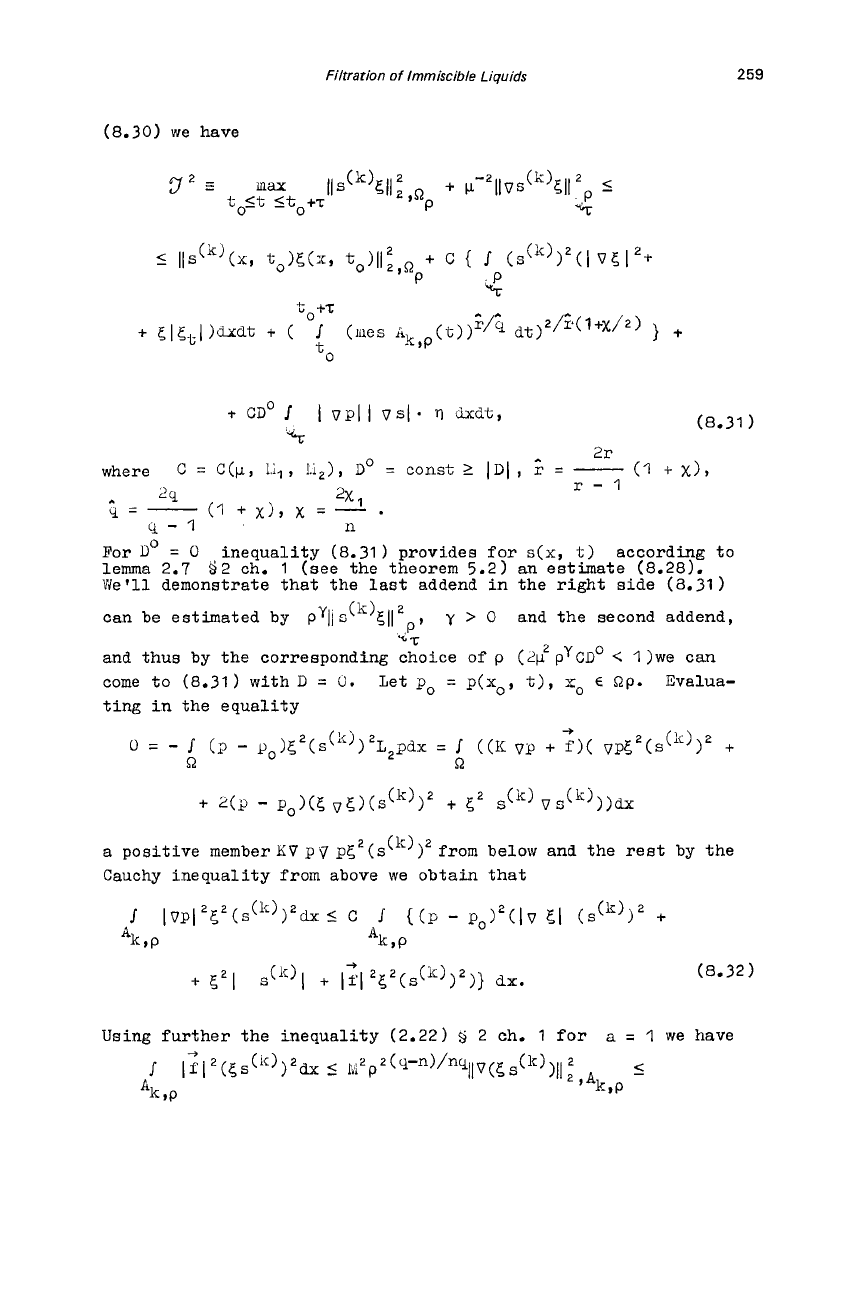
Filtration
of
Immiscible Liquids
(8.30) we have
259
2r
where
c
=
C(p,
l.il,
Liz),
Do
=
const
2
ID1
,
>
=
-
(1
+XI,
r-I
zq
2Xl
q=-
(1
+
XI,
x
=
-
-
q-1
n
For
Do
=
0
lemma
2.7
$2 ch.
1
(see the theorem 5.2) an estimate (8.28).
We'll demonstrate that the last addend in the right side
(8.31)
can be estimated by
pYl]s(k)c112D'
inequality (8.31) provides for
s(x,
t)
according
to
y
>
0
and the second addend,
X'T
and thus by the corresponding choice of
p
(2;
pYCDo
<
I
)we can
come to (8.31) with
D
=
0.
ting in the equality
Let
po
=
p(xo,
t),
yo
E
Qp.
Evalua-
a positive member
KV
pJ
pg2(s("))2
from below and the rest by the
Cauchy inequality from above we obtain that
Using further the inequality (2.22)
$j
2
ch.
1
for
a
=
1
we have
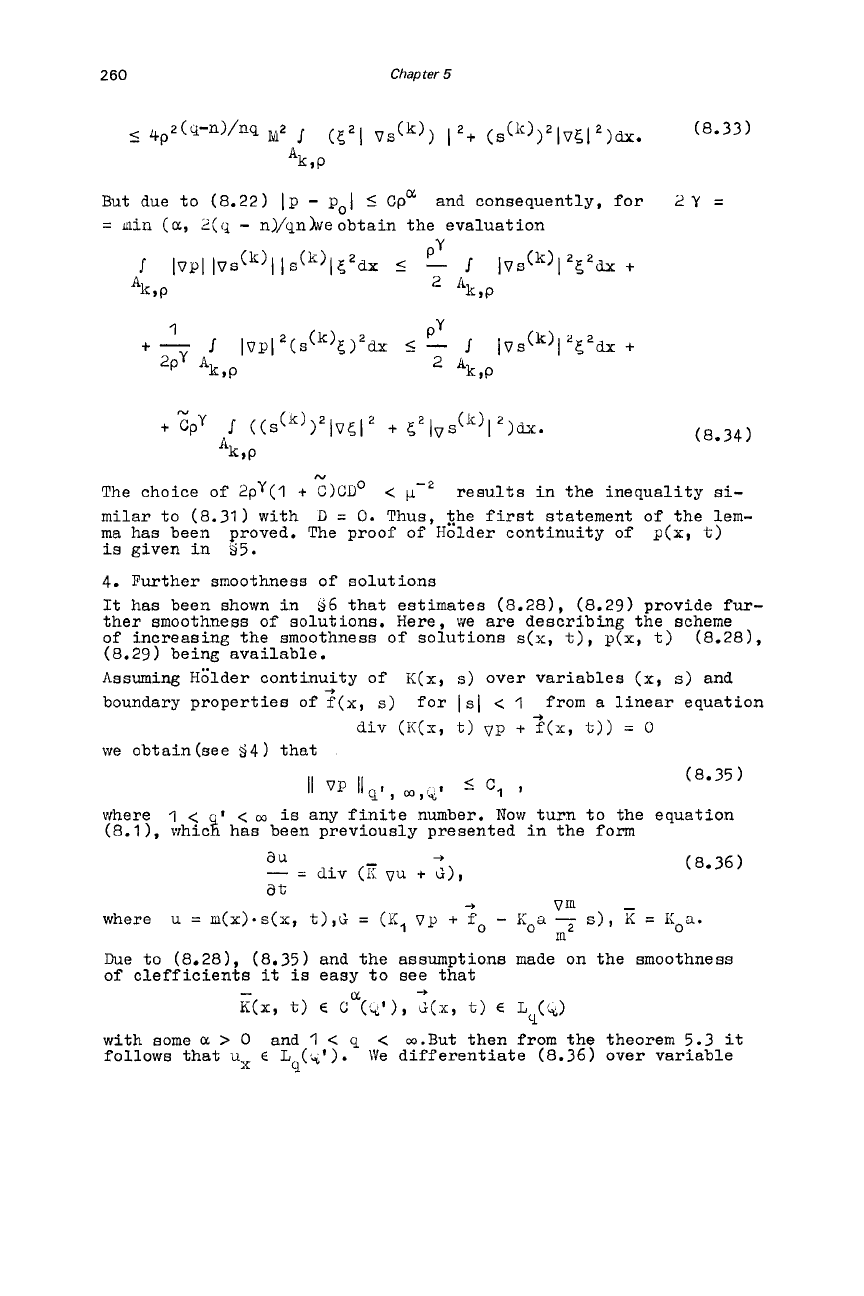
260
Chapter
5
But due to
(8.22)
Ip
-
pol
5
Cp"
=
illin
(a,
2(q
-
n)/qnheobtain the evaluation
and consequently, for
(8.33)
2y
=
(8.34)
N
The choice of
2py(1
+
C)CDo
milar to (8.31) with
D
=
0.
Thus, the
first
statement of the lem-
ma
has been
proved. The proof of Hb;lder continuity
of
is
given in
65.
4. Further smoothness of solutions
<
p-'
results in the inequality
si-
p(x,
t)
It
has been shown in
d6
that estimates
(8.281,
(8.29)
provide
fur-
ther smoothness of solutions. Here, we are describing the scheme
of increasing the smoothness of solutions
s(x,
t),
p(x,
t)
(8.281,
(8.29)
being available.
Assuming
Hglder continuity of
K(x,
s)
over
boundary properties
of
f(x,
s)
for
Is1
<
1
div
(K(s,
t)
vp
+
we obtain (see S4) that
-3
II
VP
Ilg,
w,h8
<-
c,
9
variables
(x,
s)
and
from
a
linear equation
+
f(x,
t))
=
0
(8.35
1
where
1
4
8
<
is
any finite number.
Now
turn to the equation
(8.11,
vrhic8 has been previously presented in the form
-3
Vm
-
where
Due
to
(8.281,
(8.35)
and the assumption8 made on the smoothness
of
clefficients
it
is
easy to see that
u
=
m(x).s(x,
t),G
=
(K,
vp
+
fo
-
Koa
7
s),
K
=
K0a.
m
-3
a
5%
t)
E
c
(%I),
G(x,
t)
E
L'p
with some
a
>
0
and
1
<
q
<
m.But then from the theorem
5.3
it
follows that
ux
E
Lq(yll).
\Ve differentiate (8.36) over variable
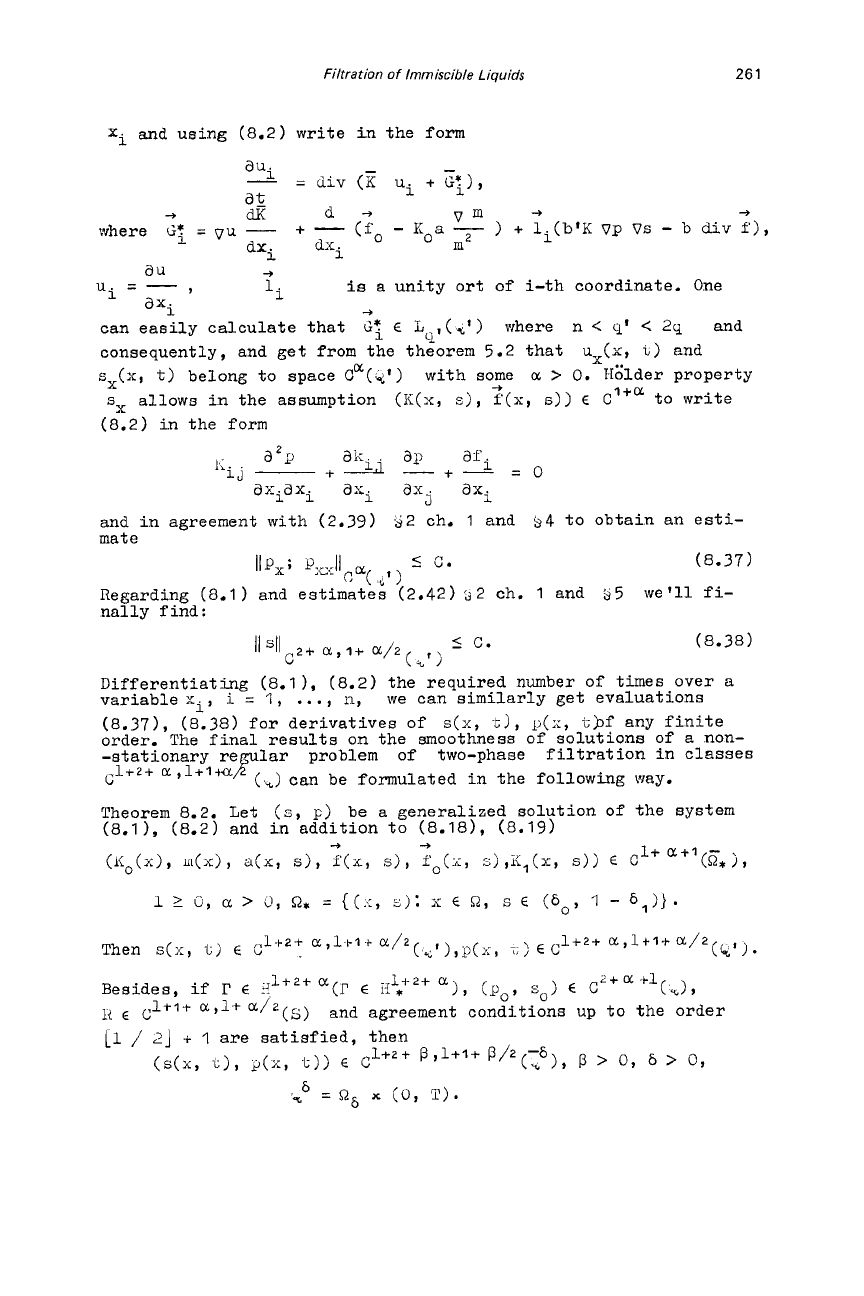
Filtration
of
immiscible Liquids
261
Xi
and using
(8.2)
write in the form
aui
-
-
-
=
div
(K
ui
+
GI),
-+
-3
a5
-+
dx
d-t
vm
where
Gz
=
vu
-
au
-3
+
-
(fo
-
R,a
-
)
+
li(b'K
Vp
0s
-
b
div
f),
dxi
dXi
m2
is
a unity ort of i-th coordinate. One
li
u.
=
-
,
axi
-9
can easily calculate that
GI
E
L
(.<')
where
n
<
y'
<
29
and
consequently, and get from the theorem
5.2
that
sx(xl
t)
belong to space
Ca(d')
sx
allows
in
the assumption
(8.2)
in the form
Y
'
u,(x,
L)
and
with some
a
>
0.
IIb;lder property
(K(x,
s),
f(x,
6))
E
C1+cL
to write
-+
,.
,
a2p
a;.
.
ap
afi
yJ
-
+
2
-
+-
=o
axiaxi
asi
ax.
axi
J
and
in
agreement with
(2.39)
$2
ch.
1
and
94
to obtain an esti-
mate
Ibx;
P:Jl
5
2.
(8.37)
C"(
)
Regarding
(8.1)
and estimates
(2.42)
'32
ch.
1
and
35
we'll
fi-
nally find:
(8.38)
Differentiating
(8.1),
(8.2)
the required
number
of times over
a
variable
xi,
i
=
1
,
. . .
,
11,
(8.371,
(8.38)
for derivatives of
s(x,
t),
lj(Xl
t)3f
any finite
order. The final results
on
the smoothness of solutions of
a
non-
-stationary re
lar
problem of two-phase filtration in classes
c
'+'+
a
ll+liaq.x)
can be formulated in the following way.
Theorem
8.2.
Let
(s,
p)
be a generalized solution of the system
(8.1),
(8.2)
and
in
addition to
(8.181,
(8.19)
we can similarly get evaluations
1+a+1
-
3
-3
(I<~(X),
u(x),
a(x,
s),
f(x,
s),
To(:<,
9)
,iil(x,
s))
E
c
(Q,
j
12
0,
CL
>
3,
Q*
=
{(,~:,
E):
x
E
Q,
s
E
(60,
1
-
61)j.
(k'l.
l+2+
CL,ltl+
a/2
Then
s(x,
1;)
E
C1-ket
Besides,
if
I'
E
21f2+CL
(r
E
(<f),p(X,
7.:
E
c
a),
(.pol
(%)
1
1{
E
C1+'+
[1
/
21
+
1
are satisfied, then
a/2(s)
and agreement conditions up to the order
l+z+
p,1+1+
p/z
-6
(s(x,
t),
p(x,
t))
E
c
(%
P
>
0,
6
>
0,
;6
=
Q6
x
(0,
r).
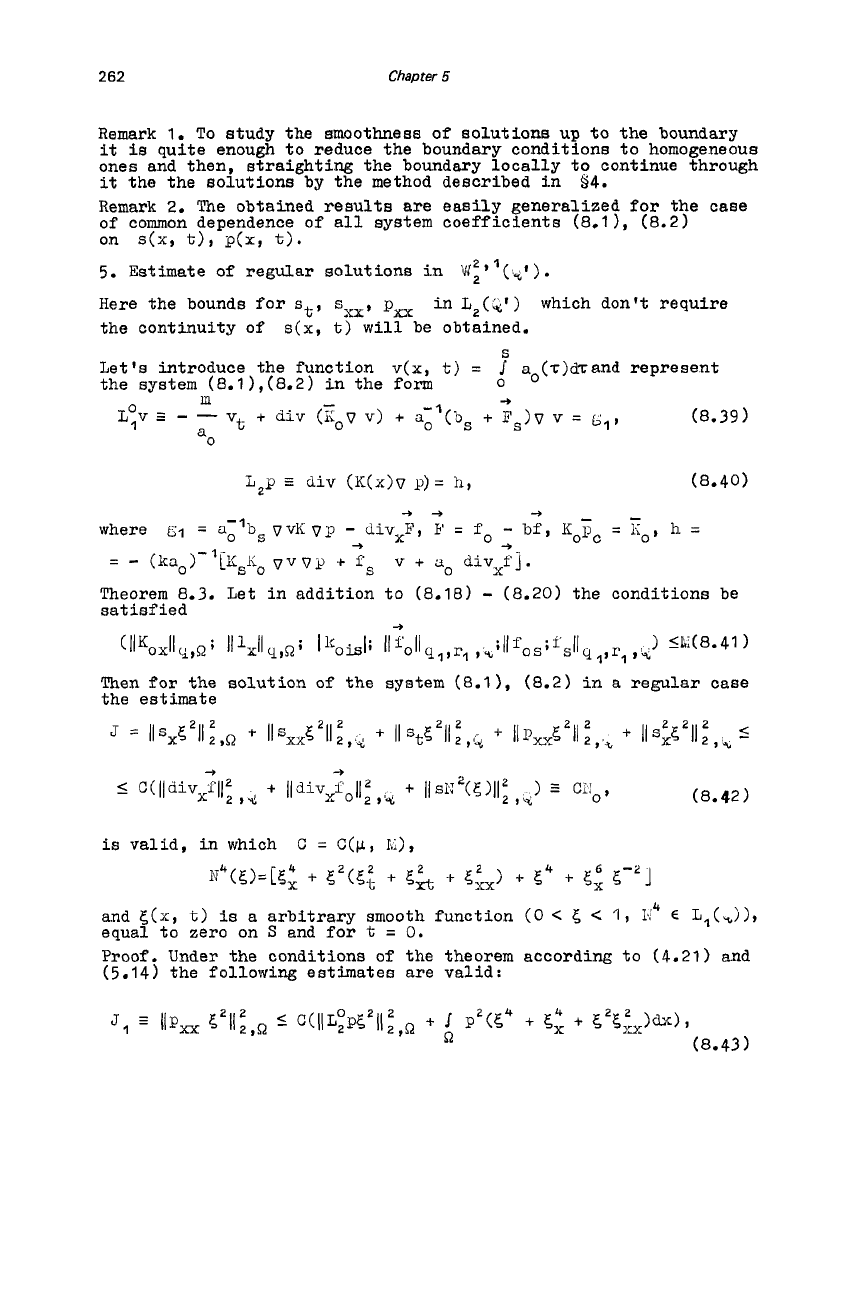
262
Chaoref
5
Remark 1.
To
study the smoothness of solutions up to the boundary
it
is
quite enough to reduce the boundary conditions to homogeneous
ones and then, straighting the boundary locally to continue through
it
the the solutions by the method described in
94.
Remark 2. The obtained results are easily generalized
for
the case
of conunon dependence of all system coefficients (8.11,
(8.2)
on
s(x,
tl,
dx,
t).
5.
Estimate
of
regular solutions in
Here the bounds for
st,
sxx,
p,
the continuity
of
~(x,
t)
will
be obtained.
Let’s introduce the function
v(x,
t)
=
a,(t)dtand represent
il;”(%’).
in
L2(%’)
which don’t require
S
the system
(8.1),(8.2)
in the
form
0
+
(8.39
1
.l
Ill
-
a
0
L,v
a
-
-
vt
+
div
(X0V
v)
+
a;
(bs
+
Fs)v
v
=
b,,
0
L2p
=
div
(K(x)v
p)=
h,
(8.40)
33
+--
where
=
VVK
vp
-
div,P,
E’
=
f
-
bf,
Kop,
=
KO,
h
=
+
0-3
=
-
(kao)-lLKshov~vp
+
fS
v
+
cto
dlvxlj.
Theorem
8.3.
Let in addition to (8.18)
-
(8.20) the conditions be
satisfied
3
)
IL‘(8.41)
Then
for
the
solution of the system (8.11,
(8.2)
in
a regular case
the estimate
(tlKoxll
q,Qi
It
qI
y,Q
i
I
lcojJi
II
Toll
q1
,r,
’
ill
fos
i
.f
sll
y
r,
,
%
J
=
IIsx5
1I2,Q
+
IISxxS
Il2&
+
Ibt5
l12,k
+
II”&
112,t
+
Ibx5
112’%5
22 22 22 22 222
is
valid, in which
C
=
C(1,
Ti;),
+
c4
(8.42)
and
<(x,
t)
is
a arbitrary smooth function
(0
<
5
<
1,
I,:4
E
Ll(%)),
equal to zero on
S
and for
t
=
0.
Proof. Under the conditions of the theorem according to (4.21) and
(5.14) the following estimates are valid:
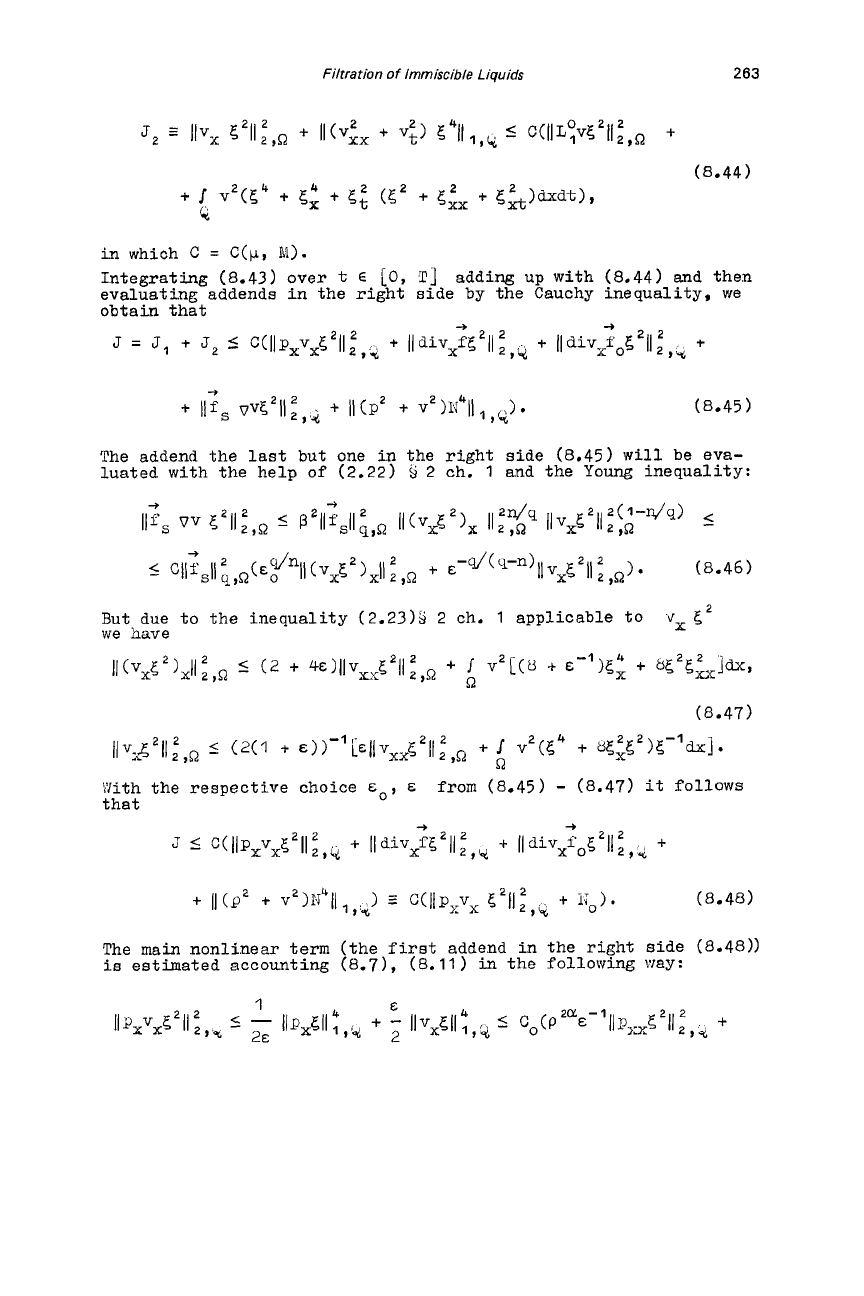
Filtration
of
Immiscible Liquids
263
2
4
J,
=
llvx
5211;,a
+
llbxx
+
v;>
5
5
C(IIL~V521/~,Q
+
(8.44)
2
+
I
v2(E4
+
5:
+
5;
(5'
+
5,,
+
5&)dxdt>,
c.
in
which
C
=
C(p,
N).
Integrating (8.43) over
t
E
[O,
TI
evaluating addends in the
right
side
by
the Cauchy inequality, we
obtain
that
adding up
with
(8.44) and then
22
-t
22
-3
22
J
=
J,
+
J,
5
C(IIPXVX5
(I2,*
+
IIdivxf5
l12,u
+
lldivxfo5
Il2,%
+
The addend the
last
but
one in the right side (8.45)
will
be eva-
luated
with
the help of
(2.22)
5,
2
ch.
1
and the
You
inequality:
(8.47)
With
the respective choice E~,
E
that
from (8.45)
-
(8.47)
it
follows
The main nonlinear term (the
first
addend in
the
right
side (8.48))
is
estimated accounting
(8.71,
(8.11)
in the following way:
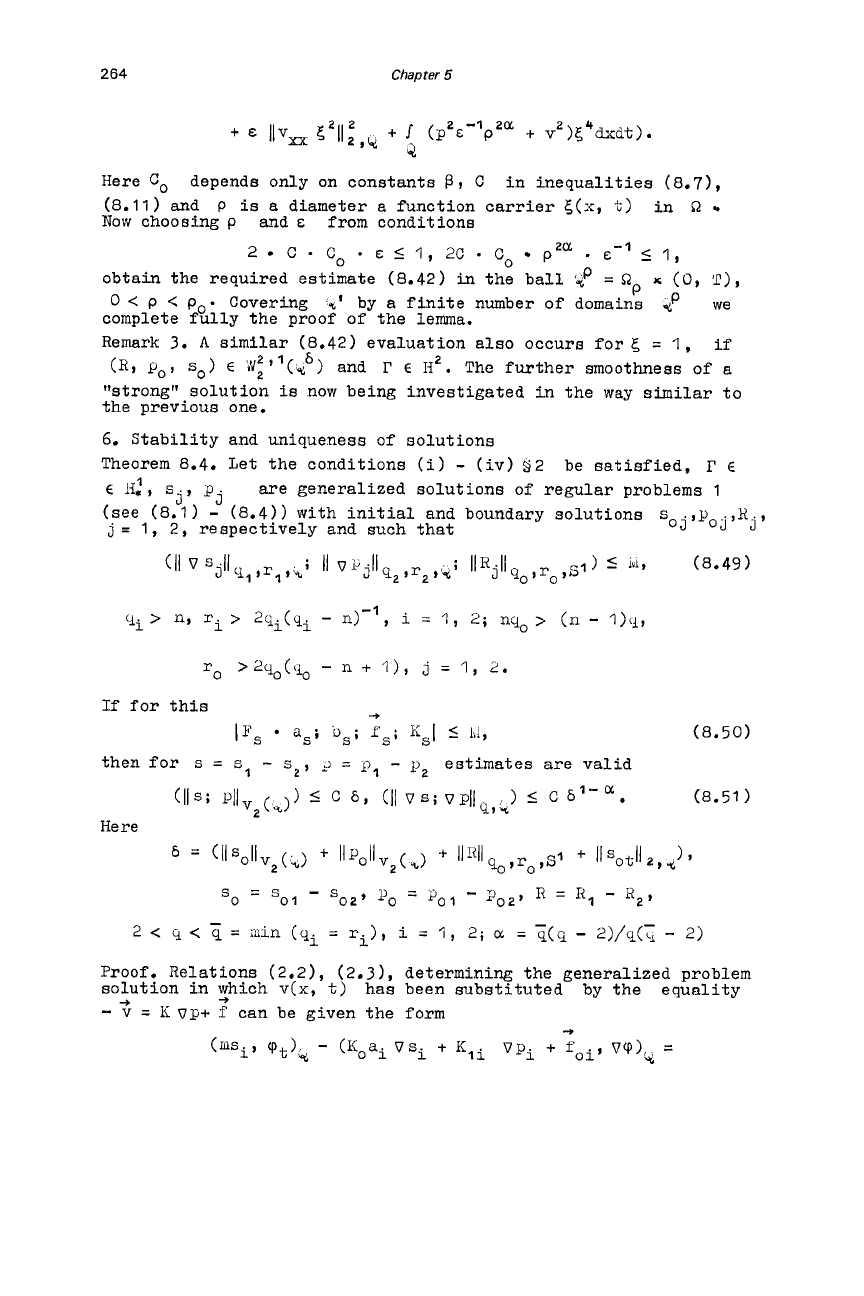
264
Chapter
5
2
-1
POL
+
E
IIvxx
5
22
IIP,k?
+
J
(p
E
p
+
v2)g4dxdt).
4
Here
co
depends only on constants
C
in inequalities
(8.71,
(8.11)
and
P
is
a
diameter a function carrier
<(x,
t)
in
L!
Now
choosing
p
and
E
from conditions
obtain the required estimate (8.42)
in
the ball
,p
=
Qp
Y
(0,
T),
0
<
p
<
p,.
Covering by
a
finite number
of
domains
$
we
complete fully the proof
of
the lemma.
Remark
3.
A
similar (8.42) evaluation
also
occurs for
5
=
1,
if
(R,
pol
so>
E
VV;”(%~)
and
I?
E
I?.
The further smoothness of
a
”strongtt solution
is
now being investigated in the way similar to
the previous one.
6.
Stability and uniqueness
of
solutions
Theorem 8.4. Let the conditions
(3.1
-
(iv)
92
be satisfied,
r
E
E
id,
SJ’
PJ
(see
(8.1)
-
(8.4)) with initial and boundary solutions
soJ,poJ,XJ1
j=
1,
2,
respectively and such that
2
c
-
co
*
E
5
1,
2c
-
c,
p2”
.
&-I
5
1,
are generalized solutions
of
regular problems
1
ro
>2qo(qo
-
n
+
I),
j
=
I,
2.
-t
If
for
this
Ips
as;
us;
Is;
Iisl
<-
I\,,
then for
s
=
s1
-
s2,
=
p,
-
11,
estimates are valid
(8.50)
(8.51)
1-
OL
(11s;
IJllv2(2)
)
5
c
6,
(I1
vs;
vPIIq,x)
5
c
6
=
~ll~,IlVP(~)
+
llPOIlV2(~)
+
11
’11
q,
,
ro
,
s
1
+
II
soJl 2,
Here
I
so
=
s
o1
-
Soz9
12,
=
gO1
-
r)02t
R
=
13,
-
R,,
-
2
<
q
<
4
=
un
(qi
=
ri),
i
=
I,
2;
CL
=
q(q
-
2)/q(T
-
2)
Proof. Relations (2,2),
(2.31,
determining the generalized problem
solution in zhich
v(x,
t)
has been substituted by the equality
-
v
=
li
vp+
f
can be given the form
+
-t
(mi,
qk)%
-
(Koai
vsi
+
Kli
vpi
+
foi,
VT);
=
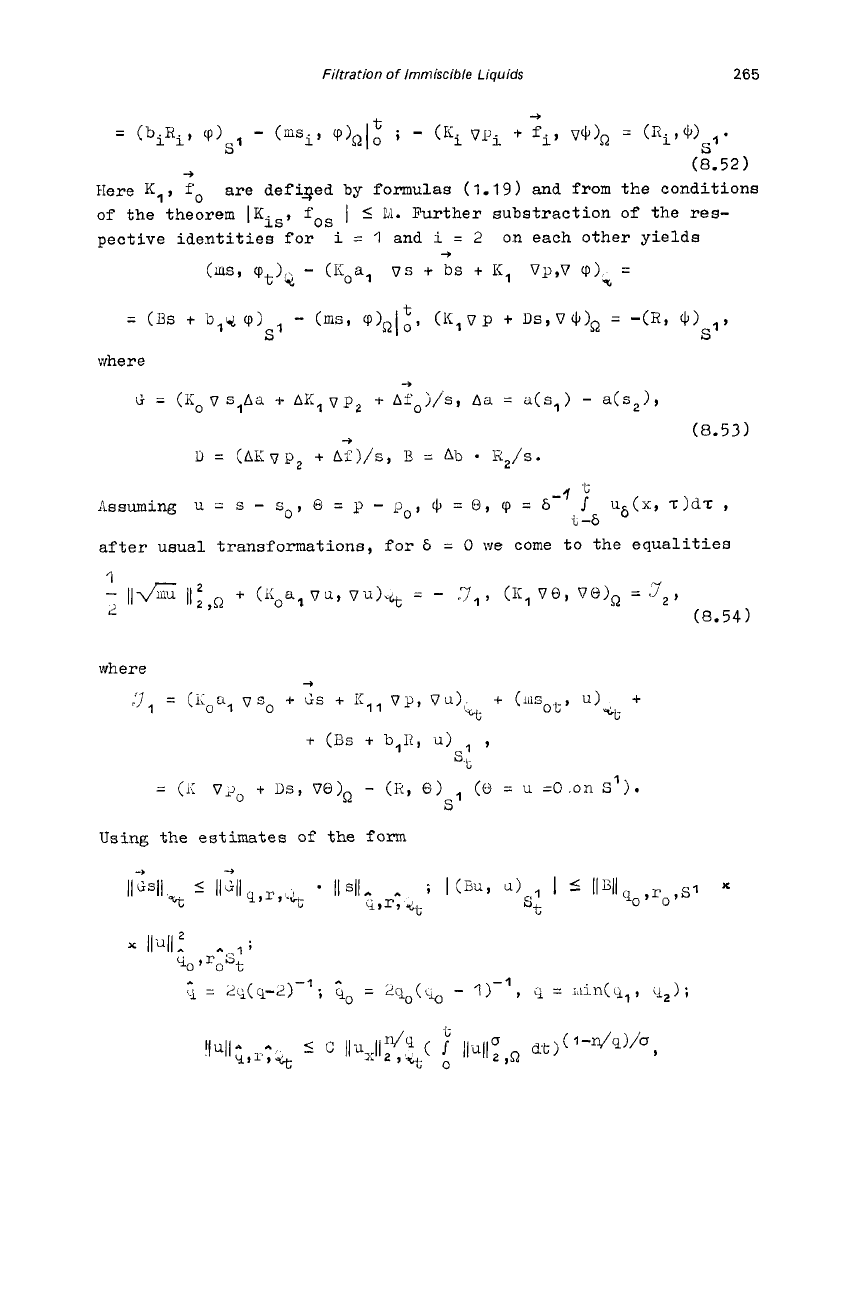
Filtration
of
lmmiscible Liquids
265
-+
t
51
*
=
(billi,
(PIsl
-
("si,
P)Q(,
i
-
("i
v7ili
+
fi,
v$>,
=
(Rip$)
-+
(8.52)
Here
K,,
fo
of the theorem
IKis,
fos
I
5
LI.
Further substraction
of
the
res-
pective identities for
i
=
1
and
i
=
2
on
each other yields
are defiqed by formulas
(1.19)
and
from
the conditions
-+
(US,
qt)L?
-
(Ii0al
vs
+
bs
+
XI
Vp,V
q)%
=
t
S1'
=
(Bs
+
blu
q>
-
(as,
cp),/,,
(lClvp
+
DS,VJ,)~
=
-(R,
'4)
S'
where
-+
ii
=
(K
01
v
s
Aa
+
AK,
vp2
+
Afo>/s,
An
=
a(sl>
-
a(s,>,
(8.53)
-+
U
=
(AK;p2
-+
Af)/s,
U
=
Ab
*
R,/s.
1-
i.
-6
Assuming
u
=
s
-
so,
Q
=
p
-
p,,
J,
=
0,
q
=
6-'
.f
u&(x,
T)dT
,
after usual transformations, for
6
=
0
we
come to the equalities
where
+
J
=
(i;
a
vs
+
GS
+
icl1 vp,vuj
+
(uis
u)
+
OL-'
$L-
'%
1
01
0
+
(Bs
+
b1E,
Uj
,
s:.
1
=
(I:
vi,
+
us, TO),
-
(R,
0)
(0
=
u
=O
on
S
j.
S1
Using
the estimates of
the
form
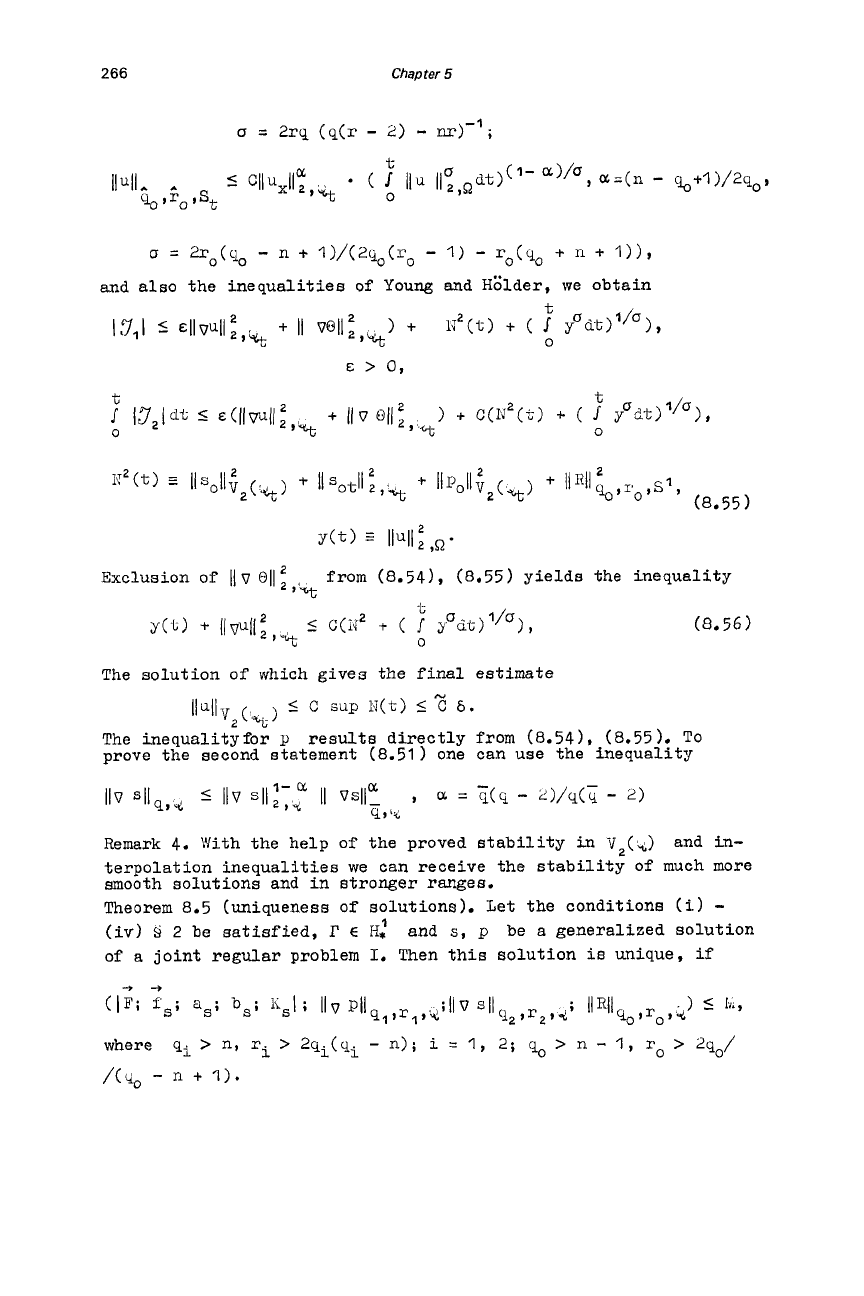
266
Chapter
5
u
=
2ro(q0
-
n
+
1)/(2q~(r~
-
I)
-
ro(qo
+
n
+
I)),
and
also the inequalities of
Young
and HElder, we
obtain
2
Y(t)
5
llul12
,Q'
Exclusion
of
117
Oll~,kt
from (8.541, (8.55) yields the inequality
(8.56)
The solution
of
which gives the
final
estimate
(ILll/v
(
)
5
c
sup
1Kt)
5
z
6.
2
iu
The inequalityfor
y
results directly from (8.541, (8.55). To
prove
the
second statement (8.51) one can use the inequality
Remark 4.
With
the help
of
the proved stability in
v,(%)
terpolation inequalities we can receive the stability of much more
smooth solutions and in stronger
ranges.
Theorem 8.5 (uniqueness of solutions). Let the conditions
(i)
-
(iv)
Si
2
be
satisfied,
I'
E
14
of
a joint regular problem
I.
Then
this
solution
is
unique,
if
and
in-
and
s,
p
be
a
generalized solution

Filtration
of
Immiscible Liquids
26
7
The proof results from theorem
8.4
for
so
=
po
=
7. Asymptotic behaviour of solutions for
t
-B
m.
Let, begining with a certain momentum
t
=
t
in
a
non-statio-
nary problem
I
=
0.
=
~)~(x),
sol
=
s0(s);
R(x,
t)
=
Ii(x),
(8.57)
S2
and
sp(x),
p2(x)
be
its
stationary solution.
Theorem
8.6.
Let
s,(x,
t),
pl(x,
t)
be a solution of
a
non-sta-
tionary problem
I
with
boundary functions, satisfying (8.57). Then
under the conditions of the theorem 7.4 (uniqueness of solutions
of a ntationary problem) there exists
an
estimate
ties
for
d
dt
-
s
=
s1
-
02;
p
=
p,
-
p,.
Proof. LIaking up
similar
to 7.4 the difference of integral identi-
we come to the following equalities
for
u(si),
pi,
i
=
1,
2
in which the coefficients are defined by formulas (7.24).
Hence, owing
to
(7.25) we obtain by a common method for
y(L)
=
=
11
,Q
the inequality
cl
-
dt
Y'
+
V0Y(Lj
5
-
I!-Jrav
+ V(l
-
A")IlV
Llll:,,
s
0,
s(2i
=
Yo,
where
vo
=
v(l
-
iio)C(.tm
11,
iiin
-).
The solution of the last yields the required bound for
8:
(lSl[Z,n
5
CY(L)
5
YC~)
ew
{-
v,t
}
The estimate for p results from (7.25).
9
DEGENERATING
NON-STATIO?ARY
PROBLEM
1.
Introduction
Let a saturation
s(x,
t)
in
a
considered problem
of
two-phase
filtration be able to achieve residual values
Q
=
0,l and in
respect to this the parabolic equation (1.7) be able to degene-
rate
(a(uj
=
d(1)
=
0).
The last condition complicates essen-
tially the study of further smoothness of a generalized solution,
received in
d
3.
The question of the continuity of
a
generalized
solution
of
even one parabolic equation (for instance (5.2))
